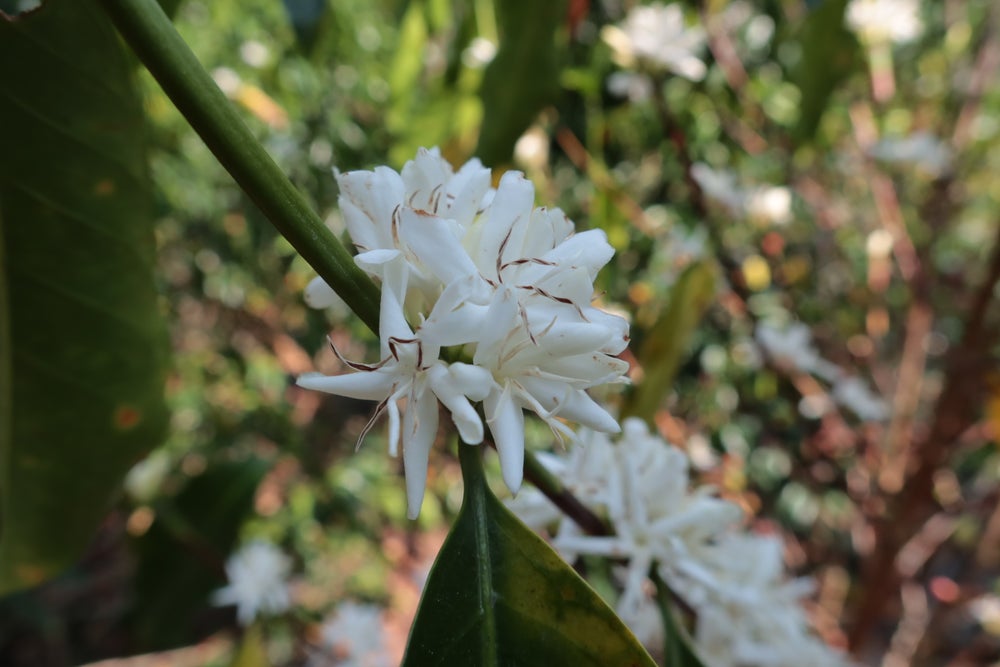Cultivation
Fredy’s farm has ideal conditions for specialty coffee production. The soil has a pH between 5.0 and 6.0 and the texture is loam and sandy loam. He maintains the nutrient-rich soil by applying fertilizer 4 times per year. His fertilizer is comprised of composted pulp, guano (bird feces rich in nitrogen) and potassium sulfate.
Fredy’s Geisha trees were planted in 2018. In addition to Geisha, he also cultivates Bourbon, Typica nad Caturra varieties. These trees are grown in the shade of guava, pine, laurel and cedar trees.
Harvest & Post-Harvest
Fredy trains all his staff in selective hand harvesting to ensure that only the ripe, red cherry is selected. Cherry is pulped the same day on an electric pulper and fermented in concrete tanks for 18 to 24 hours. Fredy washes coffee in clean water to remove remaining mucilage. Wastewater on the farm is filtered to protect the environment and local waterways. Once clean, parchment is shaken through screens that remove broken or misshapen beans. Parchment is laid on raised beds in parabolic dryers. Parchment is raked frequently to ensure even drying. It takes approximately 15 to 20 days for parchment to dry.
CENFROCAFE
CENFROCAFE began in October 1999 in Palla Peña, a town in a district of San Ignacio. Originally named Central de Asociaciones, the group was formed by 11 associations that represented a total of 220 producers.
The cooperative soon grew beyond its original purposes and began working with CEPICAFE, a cooperative for smallholders in Peru. CENFROCAFE exported its first 60 containers with help from CEPICAFE in 2006 and in 2009, became a direct exporter itself. Today, CENFROCAFE boasts over 3,000 members who are organized into 84 associations.
CENFROCAFE’s work on improving member livelihoods and increasing coffee quality has already seen significant results. Farmers with CENFROCAFE have an average yield of 1,133 kilograms, about 18.8-60kg bags per hectare. This is almost a full 60kg bag more than the average organic yield of 1,080 kilograms, or 18-60kg bags per hectare. For farmers with smaller plots, this can make an enormous difference in their income and ultimately, their lives.
To accomplish this, they focus on the educational, financial and social needs of their members. CENFROCAFE provides trainings at both the farmer and association level on best agricultural practices in organic coffee farming, infrastructural improvements and more. A solidarity fund helps associations make inputs such as organic fertilizers more accessible for farmers. Additional funds, bolstered by the Fairtrade Social Premium, help farmers pay for healthcare, funerals, farm maintenance and improvements, and more. The Social Premium also funds several awareness and prevention days to help communities increase overall health.
About Geisha
Geisha (also known as Gesha) is known for its exceptional cup quality, especially when grown at high altitudes. The variety comes from Ethiopian landrace coffees and was collected from Ethiopian coffee forests in the 1930s. The name supposedly derives from Ethiopia’s Gori Gesha forest.
There is some confusion with several genetically distinct varieties that have all been called Geisha, but the most famous variety is the Panama one. The variety was brought to Lyamungu research station in Tanzania and from there to Centro Agronómico Tropical de Investigación y Enseñanza (CATIE) in Central America in 1953. At CATIE, the variety was logged as T2722. CATIE distributed T2722 across Panama in the 1960s for its Coffee Leaf Rust (CLR) resistance, but its brittle branches meant it was not widely planted.
Panama Geisha reached its modern fame in 2005 when a Geisha lot won the “Best of Panama” competition and broke contemporary records at over $20/pound. DNA analysis has demonstrated that the Panama Geisha descended from T2722 is distinct and uniform. Today, Geisha is known for its delicate florals, jasmine and stone fruit.
Coffee in Peru
Peru holds exceptional promise as a producer of high-quality coffees. The country is the largest exporter of organic Arabica coffee globally. With extremely high altitudes and fertile soils, the country’s smallholder farmers also produce some stunning specialty coffees.
Though coffee arrived in Peru in the 1700s, very little coffee was exported until the late 1800s. Until that point, most coffee produced in Peru was consumed locally. When coffee leaf rust hit Indonesia in the late 1800s, a country central to European coffee imports at the time, Europeans began searching elsewhere for their fix. Peru was a perfect option.
Between the late 1800s and the first World War, European interests invested significant resources into coffee production in Peru. However, with the advent of the two World Wars, England and other European powers became weakened and took a less colonialist perspective. When the British and other European land owners left, their land was purchased by the government and redistributed to locals. The Peruvian government repurchased the 2 million hectares previously granted to England and distributed the lands to thousands of local farmers. Many of these farmers later grew coffee on the lands they received.
Today, Peruvian coffee growers are overwhelmingly small scale. Farmers in Peru usually process their coffee on their own farms. Most coffee is Fully washed. Cherry is usually pulped, fermented and dried in the sun on raised beds or drying sheds. Drying greenhouses and parabolic beds are becoming more common as farmers pivot towards specialty markets.
After drying, coffee will then be sold in parchment to the cooperative. Producers who are not members of a cooperative will usually sell to a middleman.
The remoteness of farms combined with their small size means that producers need either middlemen or cooperatives to help get their coffee to market. Cooperative membership protects farmers greatly from exploitation and can make a huge difference to income from coffee. Nonetheless, currently only around 15-25% of smallholder farmers have joined a coop group.

